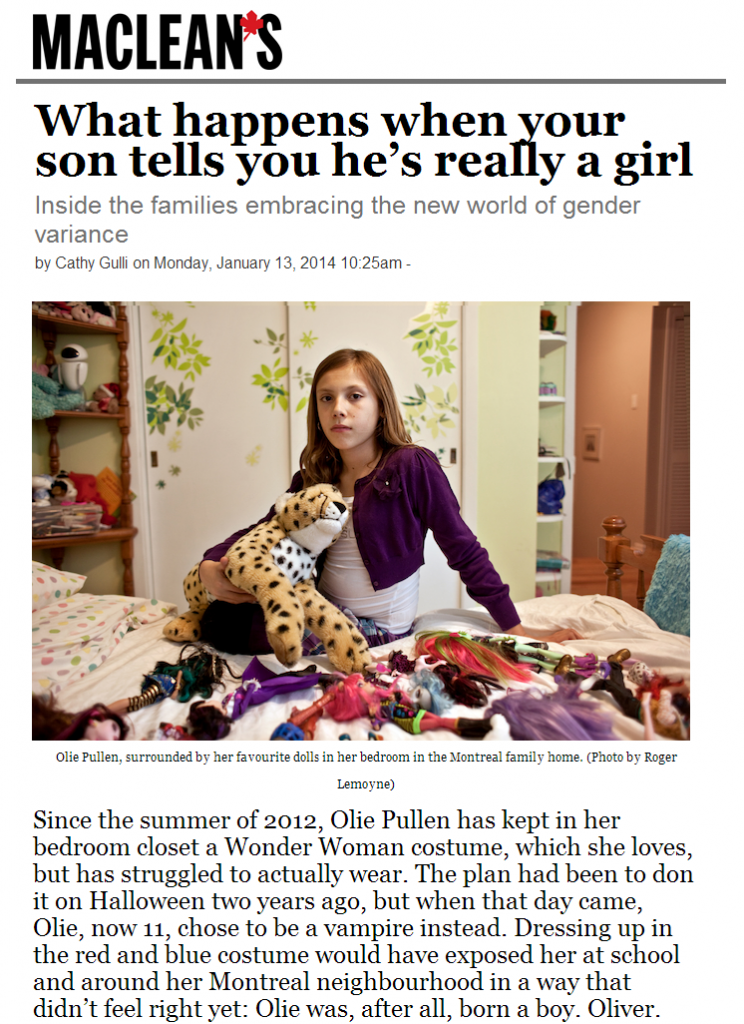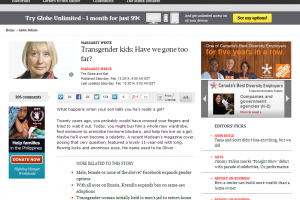I was deeply dismayed when the Globe and Mail published a transphobic article written by Margaret Wente over the weekend. I bring it up because on the outset that article seems innocuous. Clearly the editorial staff didn’t see any problem with it.
To give a bit of context, this article follows a positive piece done by MacLean’s on gender variant children. If you haven’t read it already, I would recommend that you do so. I’ll wait.

Margaret Wente’s article by contrast has a negative take on trans and gender creative youth. She perpetuates harmful misconceptions and concludes by advocating against acceptance of these children’s expression. Absent from her article are the voices of the subjects for whom this is supposedly written to benefit: the children or their adult selves. Instead, she only gives platform to their detractors.
I want to talk about this because this is what transphobia and for that matter homophobia looks like in Canada. It’s damage can not be understated. Mainstream society has a misguided belief that gay marriage and bashings serve as indicators of bigotry. This is only partly true. The brunt of the hostilities are manifested in an environment constantly hostile to genuine expression.
It’s everywhere. Canadian politicians openly equate trans women with pedophiles. Films and television shows aired in Canada regularly treat trans folk as no more than living jokes. Positive portrayals are so rare as to be applauded. Ontario schools still move to ban support groups aimed at queer youth.
Then there’s the public whose views lag the legislative framework. 74% of trans students report receiving verbal harassment over their gender expression. 37% report being physically harassed. 64% report feeling unsafe at school. Half the homeless youth in Ottawa are queer. 57% of trans people face lack of acceptance from coworkers. When we are talking about acceptance around youth, we are talking about saving lives.
Margaret Wente contributes to a climate that views diverse gender expression as something to be suppressed. Let’s look at glimpses of her article in more detail.
What happens when your son tells you he’s really a girl?
Twenty years ago, you probably would have crossed your fingers and tried to wait it out. Today, you might buy him a whole new wardrobe, find someone to prescribe hormone blockers, and help him live as a girl. Maybe he’ll even become a celebrity. A recent Maclean’s magazine cover, posing that very question, featured a lovely 11-year-old with long, flowing locks and enormous eyes. His name used to be Oliver.
What’s noteworthy here is that the subject is a young girl. This is her identity and has been for as long as she’s had the ability to express herself. She’s been seeing a pediatrician at the McGill University Health Centre to assist her for years. In the MacLean’s article she affirms that “for the first time ever, she’s comfortable.”
Margaret Wente doesn’t use her name, referring to the male one she was assigned at birth, and repeatedly refers to her as “he” and “his.” The author makes it clear that there is no bar for the child to attain at which Wente would have accepted them. This sets the tone for what follows.
Suddenly transgender kids are everywhere – in the news, on Dr. Phil and in your neighbourhood. School boards have developed detailed transgender policies. Clinics to treat transgender kids have sprung up. A condition that used to be vanishingly rare, perhaps one in 10,000 children or less, now seems common. In a random sampling of 6th- to 8th-graders in San Francisco, kids were asked if they identified as male, female or transgendered – 1.3 per cent checked off the transgendered box.
…
“The No. 1 factor is the Internet,” he said. “If you’re struggling to find out where you fit, the Internet is filled with things about gender dysphoria.”
“When we ask, ‘When did you first learn about this label of gender dysphoria’, they’ll say, ‘Me and Mom watched Oprah,’ ” adds Dr. Hayley Wood, a member of his team.
References to the Internet and talk shows is meant to discredit the voices of the youth. It plays to the stereotype that these are unreliable sources of information. Granted, they absolutely can be. However, the places people go to aren’t someone’s GeoCitie’s page from 1996. It’s the Center for Addiction and Mental Health. It’s the Central Toronto Youth Services. It’s the Vancouver Coastal Health. Provincially funded establishments that use evidence-based research to inform. This is where people turn to.
Furthermore, let’s not forget that finding words that resonate from a talk show guest doesn’t invalidate your own experiences. Sometimes it’s the only place to find a voice on television that doesn’t dehumanize trans people.
The insinuation looking at the upsurge in self-identification are that this is a fad. Absent from her discussion are other reasons to account for the rise. As one person wrote: “there is no sudden “queer identity fad” caused by the internet. you’ve just been wrapped up in your sad tiny world, never noticing the expansive world of queer people you’ve been erasing the existence of by assuming they’re all cis and straight like you.”
That’s why Dr. Zucker takes a watch-and-wait approach. He even advises parents of princessy six-year-olds to say, “You’re not a girl. You’re a boy.”
And in the hotly politicized world of gender politics, that makes him, in many people’s eyes, a dangerous reactionary.
Just what constitutes a “princessy” six year old? Why should anyone shame a little child for expressing interest in any thing merely because it’s associated with girls? This mentality just makes me so sad.
Note too that those who would support such a child are attributed the hyperbolic statement of “dangerous reactionary.” The hyperbole serves to discredit them. But no one has really said that. Wente is giving them a voice she imagines.
One reason is that social norms have dramatically changed. It is now fashionable to embrace your diverse child.
The author portrays embracing a diverse child as a negative, which I find disheartening.
Parents who encourage their kids to change gender “are socially rewarded as wonderful and accepting,” while parents who try to take it slow “are seen as unaccepting, lacking in affection and conservative,” she says.
These days, parents who don’t like the slow-and-careful answer can shop for another one. Ms. Dreger is highly critical of what she calls the “hasty clinics,” which are happy to help a kid transition right away. “Parents don’t like uncertainty,” she says. “They’d rather be told, ‘Here’s the diagnosis, and it’s all gonna turn out fine.’” Teenagers can find fast help, too. Plenty of doctors are happy to help them out with hormone treatments just for the asking.
This absolutely ignores the reality of how care works. First off, please point me to one of these clinics. Then I wouldn’t of had to have waited ten months after first applying to start hormone replacement therapy, not to mention four months of having my gender deconstructed by a stranger.
It also ignores the long journey that both parent and child take. It’s not that the kid voices things on Monday and Tuesday they’re on hormone blockers. There’s a long process there. That’s the reality of the care.
For some people, including some adolescents, transgender treatment is lifesaving. But these treatments are neither simple nor benign. They may, among other things, retard maturation, suppress your growth or render you sterile. And in the end, medical science cannot create a body that makes you forget you were born the other sex.
In the end, people like Margaret Wente make sure that you never forget that you were born the other sex. Cue her opening paragraph. But the aim in medical transition isn’t to forget the past. It’s to have a future. This inability for others to get past a person’s trans history or their gender expression is something else entirely.
Disturbingly, data on long-term outcomes for transgender kids are scarce. No one is tracking the evidence on puberty-blocking intervention either.
This is factually false. There is plenty of research on puberty-blocking interventions and trans youth; Margaret Wente just had to do a quick search on Google Scholar to see as much. However, not everyone who reads her article on the Globe and Mail will fact-check this. That makes such statements harmful because they perpetuate misconceptions that could be used to delay or deny care to the youth who need it.
Here’s more unwelcome news from Ms. Dreger. A child’s gender issue may merely be a symptom of other family problems. “The dirty little secret is that many of these families have big dysfunctional issues. When you get the clinicians over a beer, they’ll tell you the truth. A lot of the parents aren’t well in terms of their mental health. They think that once the child transitions, all their problems will magically go away, but that’s not really where the stress is located.” Clinicians won’t say these things publicly, she says, because they don’t want to sound as if they’re blaming gender problems on screwed-up families.
This statement is of very shoddy journalistic integrity. These are entirely unverifiable statements. I have never heard this to actually be the case, though I am familiar with the trope. It plays into a stereotype that the reason a kid grows up gay or trans is because of their mom or family troubles.
It’s a mark of social progress that we are increasingly willing to accept people on their terms, for who they are. But maybe we’re manufacturing more problems than we’re solving. If we really want to help people, we should remember the old rule: First, do no harm.
Unfortunately, harm is exactly the outcome of not accepting children for who they are, imposing patriarchal gender roles, and denying them voice. This is the stuff that makes people seek therapy later in life. This is what transphobia looks like. It is pervasive. It is toxic. I think it’s quite telling that Margaret Wente did not choose to interview actual children or the adults they grew into, nor their families. I suspect their story would have gotten in the way of spreading falsehoods.
Gender variance isn’t abnormal with children. Some of them might end up realizing they’re gay, trans, or none of the above. Especially that latter possibility, because there is nothing wrong with a boy that plays with dolls. Nonetheless it’s perfectly okay to not know what to do when a child expresses something you don’t understand. But one thing you do know how to do is to embrace them and inform yourself.
Fear mongering articles like this want to scare you away from taking that first step of informing yourself. You’ll discover that there’s lots of avenues for support for people like you and your child. That seeking care doesn’t mean medical intervention tomorrow it just means being there for your child today. That the people you turn to aren’t doctors with revoked licenses, but mainstream practitioners. That your child is able to express themselves more authentically, however that may be, is not a bad thing.
Margaret Wente doesn’t see things that way. She doesn’t view trans and gender creative children as to be accepted. She’s not alone. Most of the country is pretty intolerant around gender expression and that has a demonstrable health impact on the recipients of their scorn.
It is not wrong for her to question practices. However, merely having an opinion does not give it equal worth. The suppression of individual expression that Margaret Wente advocates is rooted in neither science, studies, nor the voices of her subjects. They’re all quite clear on the harm of that oppression. It is only based in personal prejudice. A reputable national newspaper should know better than to be a platform on which to further marginalize a vulnerable segment of society.
I’m deeply disappointed at the Globe and Mail for having published this transphobic article.
